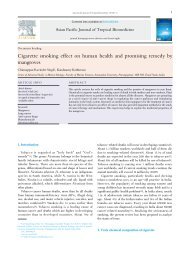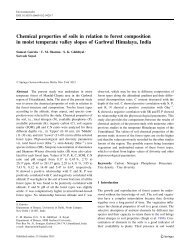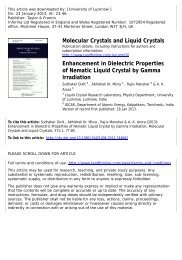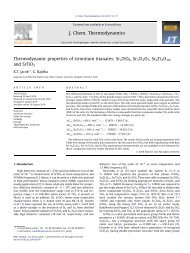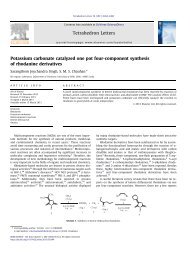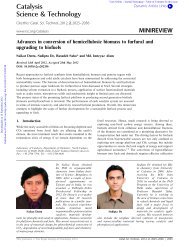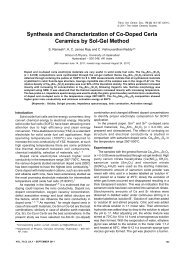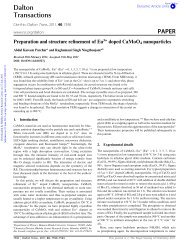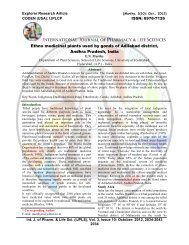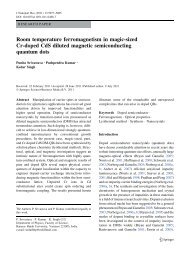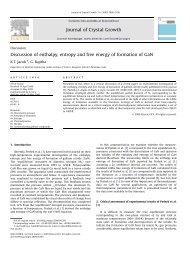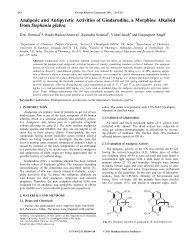The genus Stephania - Dr. DS Kothari Postdoctoral Fellowship ...
The genus Stephania - Dr. DS Kothari Postdoctoral Fellowship ...
The genus Stephania - Dr. DS Kothari Postdoctoral Fellowship ...
You also want an ePaper? Increase the reach of your titles
YUMPU automatically turns print PDFs into web optimized ePapers that Google loves.
378 D.K. Semwal et al. / Journal of Ethnopharmacology 132 (2010) 369–383<br />
the plant were shown to be as active as verapamil (standard)<br />
in reversing doxorubicin resistance in human breast cancer cells<br />
(MCF-7 cells). Isotrilobine has MDR-reversing activity comparable<br />
to verapamil at concentrations less than the ED 20 of isotrilobine<br />
on MCF-7/ADR cells. Trilobine has low activity with a slope of 28<br />
as compared with slopes of 211 and 232 for isotrilobine and verapamil,<br />
respectively. <strong>The</strong> greater efficacy of isotrilobine to trilobine<br />
appears to be a result of the methyl group at N-2 ′ . This is the only<br />
structural difference between the two compounds and suggests<br />
that a tertiary amine is preferred at this position to a secondary<br />
amine. <strong>The</strong> slightly increased lipophilicity induced by the addition<br />
of another methyl group may also contribute to the increased<br />
activity (Hall and Chang, 1997).<br />
4.9. Anti-inflammatory and analgesic activity<br />
To investigate the anti-inflammatory effects of S. tetrandra<br />
S. Moore in vitro and in vivo, its effects on the production of<br />
IL-6 and inflammatory mediators were analyzed. When human<br />
monocytes/macrophages (stimulated with silica) were treated<br />
with 0.1–10 g/mL the plant, the production of IL-6 was inhibited<br />
up to 50%. It also suppressed the production of IL-6 by<br />
alveolar macrophages. In addition, it inhibited the release of<br />
superoxide anion and hydrogen peroxide from human monocytes/macrophages.<br />
To assess the anti-fibrosis effects of S. tetrandra,<br />
its effects on in vivo experimental inflammatory models were evaluated.<br />
In the experimental silicosis model, IL-6 activities in the<br />
sera and in the culture supernatants of pulmonary fibroblasts were<br />
also inhibited by it. In vitro and in vivo treatment with S. tetrandra<br />
reduced collagen production by rat lung fibroblasts and lung<br />
tissue. It also reduced the levels of serum GOT and GPT in the<br />
rat cirrhosis model induced by CCl 4 , and was effective in reducing<br />
hepatic fibrosis and nodular formation (Kang et al., 1996). <strong>The</strong> antiinflammatory<br />
constituents, tetrandrine (18) and fangchinoline (50)<br />
from S. tetrandra have been shown to decrease IL-1beta, IL-6, IL-8<br />
and TNF-alpha as well as decrease leukotriene and prostaglandin<br />
generation. Furthermore, tetrandrine has been shown to inhibit the<br />
production of TNF-alpha and IL-6 by microglial cells (Teh et al.,<br />
1990; Xue et al., 2008). <strong>The</strong> combined analgesic effect of aconitum<br />
(Ac) and S. tetrandra (St) was found superior to that of Ac and St<br />
when used alone. <strong>The</strong> combined Ac-St showed remarkable analgesic<br />
activity within 3 h (p < 0.01) in rabbits and mice models (Li et<br />
al., 2000).<br />
4.10. Immunomodulating activity<br />
S. tetrandra S. Moore has been used to treat autoimmune<br />
diseases such as rheumatoid arthritis and systemic lupus erythe<br />
matosus. Tetrandrine (18) has potential immunomodulating<br />
and anti-inflammatory effects. T-lymphocytes play a critical<br />
role as autoactive and pathogenic population in autoimmune<br />
and inflammatory diseases. Some experimental data showed<br />
that, through down-regulating the protein kinase C (PKC) signaling,<br />
interleukin-2 secretion and the expression of the T<br />
cell activation antigen (CD71), tetrandrine inhibited phorbol<br />
12-myristate 13-acetate (PMA)+ionomycin-induced T cell proliferation<br />
dependent on interleukin-2 receptor chain and CD69,<br />
such an action was unrelated to Ca 2+ channel blockade (Ho<br />
et al., 1999). Tetrandrine (0.1–10 ML −1 ) significantly inhibited<br />
neutrophil-monocyte chemotactic factor-1 upregulation and<br />
adhesion to fibrinogen induced by N-formyl-methionyl-leucylphenylalanine<br />
and PMA. Tetrandrine at 0.1–100 ML −1 caused<br />
dose and time-dependent loss of cell viability of mouse peritoneal<br />
macrophages, guinea-pig alveolar macrophages and mouse<br />
macrophage-like J774 cells, reduced production of oxygen free<br />
radical, down-regulated synthesis and release of some proinflammatory<br />
cytokines (Pang and Hoult, 1997; Shen et al.,<br />
1999).<br />
4.11. Antifibrotic effect<br />
Antifibrotic effect of a methanol extract from S. tetrandra S.<br />
Moore on experimental liver fibrosis has been investigated. Liver<br />
fibrosis was induced by bile duct ligation and scission (BDL/S) in<br />
rats. In BDL/S rats, activity levels of aspirate transaminase, alanine<br />
transaminase, alkaline phosphatase, concentration of total<br />
bilirubin in serum, and 100 mg/kg/day or 200 mg/kg/day, (p.o. for<br />
4 weeks) in BDL/S rats reduced the serum aspirate transaminase,<br />
alanine transaminase, alkaline phosphatase activity levels significantly<br />
(p < 0.01) (Nan et al., 2000).<br />
4.12. Anti-hyperglycemic effect<br />
<strong>The</strong> ethanolic extract of the tubers of S. glabra (Roxb.) Miers<br />
was evaluated for its hyperglycemic effects against alloxan-induced<br />
diabetic and significantly decreased the blood sugar level in experimental<br />
animals (Semwal et al., 2010a). A palmatine derivative,<br />
11-hydroxypalmatine (44) isolated from this plant was also evaluated<br />
for its anti-hyperglycemic activity. <strong>The</strong> test compound was<br />
administered at doses of 25, 50, and 100 mg/kg, p.o., 36 h after<br />
alloxan injection (60 mg/kg, i.v.). <strong>The</strong> alloxan-induced diabetic mice<br />
showed significant reduction in blood glucose after treatment with<br />
the test compound by 52% as compared to the positive control<br />
glibenclamide (54%) and the diabetic control (27%) (Semwal et al.,<br />
2010b). S. tetrandra S. Moore roots increases the blood insulin level<br />
and reduces the blood glucose level in streptozotocin diabetic mice.<br />
Actions of bisbenzylisoquinoline alkaloids isolated from the plant<br />
were investigated in the hyperglycemia of diabetic mice. A main<br />
bisbenzylisoquinoline alkaloid fangchinolin (0.3–3 mg/kg) significantly<br />
reduced blood glucose level of the diabetic mice. <strong>The</strong> effect<br />
of fangchinoline was 3.9 fold greater than that of water extract<br />
(Tsutsumi et al., 2003). S. tetrandra has a direct effect on the retinal<br />
capillary of posterior ocular region and suppressed neovascularization<br />
of retinal capillary in streptozotocin diabetic rats through<br />
the activation of tetrandrine (Liang et al., 2002). <strong>The</strong> oral administration<br />
of ethanol and aqueous extract (400 mg/kg body weight) of<br />
powdered corm of S. hernandifolia significantly (p < 0.05) decreased<br />
the blood glucose of normal and Streptozotocin-induced diabetic<br />
rats up to 12 h. Glibenclamide was used as a standard drug at a dose<br />
of 0.25 mg/kg (Sharma et al., 2010).<br />
4.13. Ca 2+ channel blocking activity<br />
Abnormal Ca 2+ signaling and elevated concentration of intracellular<br />
free Ca 2+ are the basic pathophysiological events involved<br />
in various diseases. As a Ca 2+ antagonist, tetrandrine (S. tetrandra)<br />
can inhibit extracellular Ca 2+ entry, int ervene in the distribution<br />
of intracellular Ca 2+ , maintain intracellular Ca 2+ homeostasis, and<br />
then disrupt the pathological processes. As shown in whole cell<br />
patch-clamp recordings, tetrandrine blocked bovine chromaffin<br />
cells voltage-operated Ca 2+ channel current in a time and concentration<br />
dependently manner. In rat phaeochromocytoma PC 12<br />
cells, 100 mol L −1 tetrandrine abolished high K + (30 mmol L −1 )<br />
-induced sustained increase in cytoplasmic Ca 2+ concentration,<br />
inhibited bombesin-induced inositol triphosphate accumulation in<br />
NIH/3T3 fibroblast and abolished Ca 2+ entry (Takemura et al., 1996).<br />
Tetrandrine can affect cardiovascular electrophysiologic properties<br />
by inhibit the contractility, ±dt/dp max , and automaticity of<br />
myocardium, prolong the FRP, and exert concentration-dependent<br />
negative inotropic and chronotropic effects without altering cardiac<br />
excitability. Tetrandrine directly blocks both T-type and L-type<br />
calcium current in ventricular cells and vascular smooth muscle



